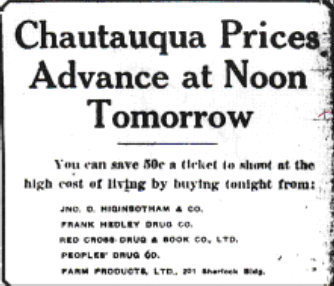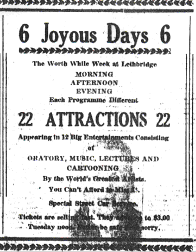
In the early part of the twentieth century, the greatest thing that many prairie towns would see was the Chautauqua. Everyone in a community would become involved in a Chautauqua. Children would dress up and parade through the streets shouting Chautauqua cheers, sporting competitions were held, and community dances lasted late into the evening. The highlight of the Chautauqua was the shows. Like a circus, three shows were held each day with such acts as pageants, international music, and theatre, as well, Chautauqua's included educational lectures and studies. To a prairie community the Chautauqua was an extraordinary sight, and Lethbridge was the first Canadian location to see one.
Chautauqua's began in New York state, near Lake Chautauqua, where the traveling show took its name from. Although best remembered for their entertainment value, the original purpose of the Chautauqua was religious education and self-improvement. In 1874 Methodist Bishop John Vincent and Lewis Miller opened a camp, and later a school at Lake Chautauqua to educate the young in academic and religious matters. Vincent and Lewis' educational views evolved, over time, into a show designed to entertain as well as educate.

The first Chautauqua was advertised in the Lethbridge Herald in July, 1917
Chautauqua spread all over the United States before its managers decided to move into Canada. The first attempts to establish a Chautauqua in Canada were unsuccessful, mostly due to the fact that the year was 1916 and Canada was at War. But, one of the managers, John Erickson, was successful. Erickson had gone to Lethbridge, where he had preached a sermon for the Presbyterian Church, soon after he signed the first Canadian contract for a Chautauqua. Soon after, Erickson signed contracts for Taber, Cayley, Nanton, and Fort Macleod. Generally, a Chautauqua contract was between 25 men from the community (this number would vary) and the Chautauqua company. The company was promised $1 500 from ticket sales with all moneys earned above that amount to be divided equally between the group of men and the company. If ticket sales failed to add up to $1 500 the group of men was responsible for the difference. One example of ticket prices from a six-day show in Blairmore in 1917 was $3 for adults and $1 for children and students.

More promotional ads to get people to attend the Chautauqua.
The Chautauqua became a big event for prairie towns and cities and their tents, as the official Chautauqua saying went, "brought the world to your door". The Chautauqua brought the world to the doors of many, expanding the horizons of those who would or could not leave their prairie world. But, the Chautauqua became another victim of when the depression in the 1930's. Poor people could not afford ticket prices and the backers were more and more often left in debt to the company. With no places to hold it the Chautauqua soon went out of business.
Previous Page | Exhibit Contents | Home | Navigation Information | Glossary | Curriculum Guide | Next Page
Copyright © 1996 Sir Alexander Galt Museum. All rights reserved.